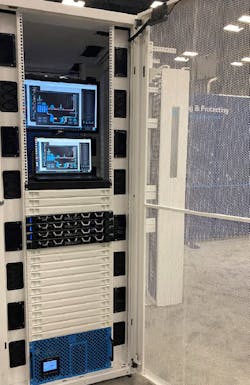Digital Resilience: Merging IT Growth with Environmental Responsibility
And while the high-speed growth of our industry has brought with it extraordinary benefits— transformed communications and worldwide connectivity—this vast growth has also raised red flags about our environmental impact.
Data Center Design Starts with the Right Cabinet Ecosystem
Various estimates find that digital pollution contributes 2.5% to 3.5% to overall global CO2 emissions. Concurrently, the energy required to power servers and related IT technology is increasing by 9% per year. Designing the best-possible data center—either within an existing footprint or from the ground up—can help future-proof an IT operation by ensuring performance, scalability, and longevity.
For companies that view environmental sustainability as an important business issue, Chatsworth Products (CPI) collaborates to explore, configure, and build robust and resilient infrastructure that can significantly reduce energy consumption and associated carbon emissions.
Toward that goal, selecting the right cabinet ecosystem is a cornerstone in promoting and improving eco-friendly practices, as it enables a company to host energy-efficient, high-density servers, power supplies, and cooling systems.
Furthermore, incorporating intelligent real-time monitoring to track power usage, temperature, and total system health optimizes energy use and enables proactive maintenance. Based on this kind of power and environmental information, predictive power modeling (PPM) helps improve capacity planning to determine the best use of space, power, and cooling resources.
PPM can also mitigate and minimize downtime in data centers by ensuring IT equipment consistently receives the appropriate voltage, frequency, and wave forms required for proper operation. Additionally, monitoring UPS battery charge or generator fuel levels ensures that devices can reliably provide the ride-though times required to sustain uptime during most outages.
Power distribution devices at the cabinet, row, or floor level have branch overcurrent protection with finite capacities. Monitoring the amperage and power usage of these devices ensures that data center operators are notified of impending issues—so corrective action can be taken before an actual downtime event.
Collectively, these tools provide invaluable insights into the performance of the cabinet ecosystem, empowering operators to make data-driven decisions that enhance efficiency and reduce costs, while helping achieve sustainability goals.
Rising Heat and the Need for Next-Gen Cooling Systems
Data center design and infrastructure has long been reflective of power and cooling requirements of four to six kilowatts per server rack. Now, however, power and server density per rack are escalating. In addition to higher thermal power, they have lower temperature requirements.
Data center operators now must predict a variety of unknowns, including the future power of their standard IT rack, the upper limits of their high-density racks, and the cooling requirements of those systems. Infrastructure budgets will influence these prognostications, meaning that adaptability in data center design and decision-making will be key.
Legacy air-based cooling systems, using fans and air conditioners to circulate cool air throughout racks and cabinets, have been a data center staple. Hot- and cold-aisles, as well as raised-floors, are common in these systems. But as the size of data centers increase and the heat they generate rises, this type of cooling is less effective.
Liquid-based, direct-to-chip, and immersion cooling systems are becoming widespread, using water and dielectric fluids to absorb heat and transport it to a heat exchanger. Since up to 40% of data center electricity is used to remove unwanted heat from IT equipment, it is becoming increasingly common to capture and repurpose that energy, which would otherwise be wasted. One of the most typical uses for this energy is to warm the air and water in the facility it comes from.
Additionally, the ability to redirect this controllable “waste heat or regular heat” at higher temperatures creates an array of possible applications for industry and agriculture, including water desalinization, greenhouses, and the manufacture of wood pellets for stoves. By embracing sustainable practices such as these, businesses can not only achieve operational cost savings but also contribute to a greener future.
Sustainability is Key for Future Success
The global IT revolution has permanently changed our world. As a driver of economic growth and 24/7 interconnectedness, it has empowered positive and transformative change. In the face of rapid and volatile change to our climate, however, the environmental impact of IT systems, infrastructure, and practices has become a challenge that cannot be understated.
At CPI, we know how much sustainability matters. Toward our own sustainability goals, we are proactively forming teams to manage several initiatives and are closely collaborating with our vendor partners to create comprehensive plans. These encompass, but are not limited to, waste reduction in manufacturing, transportation, use, and disposal; forging renewable energy partnerships; and enhancing supplier performance.
We have committed to these steps, and are exploring many others, to be in line with what we see as a global imperative—to further the undeniable benefits of “information technology” while helping minimize the industry’s environmental impact as it continues to expand.
John Thompson is Field Application Engineer at Chatsworth Products. Contact CPI to learn more about how to build a robust and resilient infrastructure that's envitonmentally sustainable.



